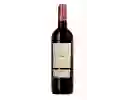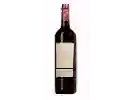
Château le RaulyLes Hauts du Rauly Pécharmant Rouge
In the mouth this red wine is a powerful with a nice balance between acidity and tannins.
This wine generally goes well with blue cheese, poultry or beef.
Taste structure of the Les Hauts du Rauly Pécharmant Rouge from the Château le Rauly
Light | Bold | |
Smooth | Tannic | |
Dry | Sweet | |
Soft | Acidic |
In the mouth the Les Hauts du Rauly Pécharmant Rouge of Château le Rauly in the region of South West is a powerful with a nice balance between acidity and tannins.
Food and wine pairings with Les Hauts du Rauly Pécharmant Rouge
Pairings that work perfectly with Les Hauts du Rauly Pécharmant Rouge
Original food and wine pairings with Les Hauts du Rauly Pécharmant Rouge
The Les Hauts du Rauly Pécharmant Rouge of Château le Rauly matches generally quite well with dishes of beef, lamb or poultry such as recipes of sweet and sour turkish dumpling soup (eksili köfte), lamb tagine with apricots or homemade meat/goat ravioli.
Details and technical informations about Château le Rauly's Les Hauts du Rauly Pécharmant Rouge.
Discover the grape variety: Phoenix
Interspecific cross between the white bacchus and the white Villard obtained in 1964 by Gerhardt Erich Alleweldt (1927/2005) at the Geilweilerhof Station in Siebeldingen, Germany. It should be noted that the sirius and the staufer were also born from these same parents. Phoenix is little known even in France, although it is registered in the Official Catalogue of varieties of table grapes on the A2 list.
Last vintages of this wine
The best vintages of Les Hauts du Rauly Pécharmant Rouge from Château le Rauly are 2015, 0
Informations about the Château le Rauly
The Château le Rauly is one of of the world's greatest estates. It offers 30 wines for sale in the of Pécharmant to come and discover on site or to buy online.
The wine region of Pécharmant
The wine region of Pécharmant is located in the region of Guyenne of South West of France. Wineries and vineyards like the Château de Tiregand or the Château Terre Vieille produce mainly wines red, white and sweet. The most planted grape varieties in the region of Pécharmant are Merlot, Cabernet-Sauvignon and Cabernet franc, they are then used in wines in blends or as a single variety. On the nose of Pécharmant often reveals types of flavors of non oak, plum or dark fruit and sometimes also flavors of black fruits, black cherries or cedar.
The wine region of South West
The South-West is a large territorial area of France, comprising the administrative regions of Aquitaine, Limousin and Midi-Pyrénées. However, as far as the French wine area is concerned, the South-West region is a little less clear-cut, as it excludes Bordeaux - a wine region so productive that it is de facto an area in its own right. The wines of the South West have a Long and eventful history. The local rivers play a key role, as they were the main trade routes to bring wines from traditional regions such as Cahors, Bergerac, Buzet and Gaillac to their markets.
The word of the wine: Vintage scale
Complex system of classification of the communes of Champagne according to the value of the grapes which are produced there. In other regions, hierarchical situation of the productions classified by various authorities.














